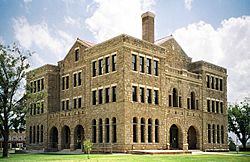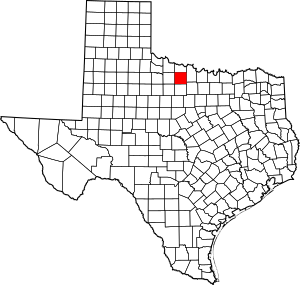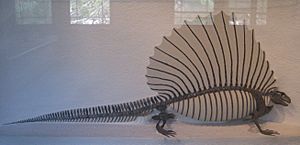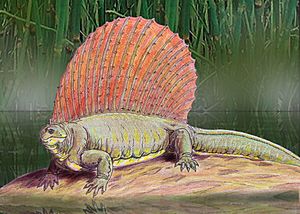Archer County, Texas facts for kids
Quick facts for kids
Archer County
|
|
|---|---|

The Archer County Courthouse in Archer City: The Romanesque style structure was added to the National Register of Historic Places in 1977.
|
|

Location within the U.S. state of Texas
|
|
 Texas's location within the U.S. |
|
| Country | |
| State | |
| Founded | 1880 |
| Named for | Branch Tanner Archer |
| Seat | Archer City |
| Largest city | Archer City |
| Area | |
| • Total | 925 sq mi (2,400 km2) |
| • Land | 903 sq mi (2,340 km2) |
| • Water | 22 sq mi (60 km2) 2.4% |
| Population
(2020)
|
|
| • Total | 8,560 |
| • Density | 9.254/sq mi (3.573/km2) |
| Time zone | UTC−6 (Central) |
| • Summer (DST) | UTC−5 (CDT) |
| Congressional district | 13th |

Archer County is a county located in the state of Texas in the United States. As of the 2020 census, about 8,560 people live there. Its main town, or county seat, is Archer City. Archer County is part of the larger Wichita Falls area.
Contents
History of Archer County
In 1858, the Texas Legislature created Archer County. It was formed from parts of Fannin County. The county officially started operating in 1880. It is named after Branch Tanner Archer. He was an important leader for the Republic of Texas.
Geography of Archer County
Archer County covers about 925 square miles (2,396 square kilometers). Most of this area, about 903 square miles (2,339 square kilometers), is land. The remaining 22 square miles (57 square kilometers) are covered by water.
Main Roads in Archer County
Several important highways pass through Archer County:
 U.S. Highway 82
U.S. Highway 82 U.S. Highway 277
U.S. Highway 277 U.S. Highway 281
U.S. Highway 281 State Highway 25
State Highway 25 State Highway 79
State Highway 79 State Highway 114
State Highway 114
Neighboring Counties
Archer County shares its borders with several other counties:
- Wichita County (to the north)
- Clay County (to the east)
- Jack County (to the southeast)
- Young County (to the south)
- Baylor County (to the west)
- Wilbarger County (to the northwest)
Geology and Ancient Life
Archer County is part of the Texas Red Beds. These are layers of red-colored rock that formed a very long time ago. They are from the Early Permian period. One famous fossil site in the county is the Geraldine Bonebed.
Fossils of ancient animals from the Permian period were first found here in 1877. Scientists have discovered rare fossils of amphibians like Trimerorhachis. They have also found many other ancient four-legged animals, called tetrapods. These include Dimetrodon and Diadectes.
Population of Archer County
| Historical population | |||
|---|---|---|---|
| Census | Pop. | %± | |
| 1880 | 596 | — | |
| 1890 | 2,101 | 252.5% | |
| 1900 | 2,508 | 19.4% | |
| 1910 | 6,525 | 160.2% | |
| 1920 | 5,254 | −19.5% | |
| 1930 | 9,684 | 84.3% | |
| 1940 | 7,599 | −21.5% | |
| 1950 | 6,816 | −10.3% | |
| 1960 | 6,110 | −10.4% | |
| 1970 | 5,759 | −5.7% | |
| 1980 | 7,266 | 26.2% | |
| 1990 | 7,973 | 9.7% | |
| 2000 | 8,854 | 11.0% | |
| 2010 | 9,054 | 2.3% | |
| 2020 | 8,560 | −5.5% | |
| U.S. Decennial Census 1850–2010 2010 2020 |
|||
In 2020, the population of Archer County was 8,560 people. The county has seen its population change over the years. For example, in 1930, there were 9,684 people, but by 1970, it had dropped to 5,759. The population has slowly grown again since then.
Education in Archer County
Several school districts serve the students in Archer County:
- Archer City Independent School District
- Holliday Independent School District
- Iowa Park Consolidated Independent School District (part of it)
- Jacksboro Independent School District (part of it)
- Olney Independent School District (part of it)
- Windthorst Independent School District
There used to be a school district called Megargel Independent School District. It served parts of Archer County but closed in 2006. For college, the county is served by Vernon College.
Ranching in Archer County
Ranching is an important part of Archer County's history and economy. A large ranch called La Escalera Ranch has a part of its land in Archer County. This part is known as the Seymour Division. It used to be called the Cross Bar Ranch. The ranch is known for its Black Angus cattle and lots of wildlife. Famous oilman and giver, Joseph Sterling Bridwell, also owned a ranch here.
Dairy Industry in Archer County
Archer County is a key area for making dairy products in Texas. The towns of Scotland and Windthorst, in the southeastern part of the county, have many dairy farms. As of 2019, there were 37 working dairy farms nearby. The dairy business started here in the early 1900s and has continued to be strong. Most of these dairy farms are owned by families. They are a big part of the local economy for these towns.
Communities in Archer County
Archer County has several towns and communities:
Cities
- Archer City (This is the county seat, where the main county offices are)
- Holliday
- Scotland
Towns
- Lakeside City
- Megargel
- Windthorst (partly in Clay County)
Unincorporated Communities
These are smaller communities that are not officially organized as cities or towns:
Ghost Towns
These are places where people used to live but are now mostly abandoned:
Images for kids
See also
 In Spanish: Condado de Archer para niños
In Spanish: Condado de Archer para niños



